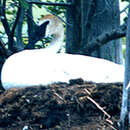More info for the terms:
formation,
severityPair formation - Trumpeter swans most often form pair bonds when they
are 2 or 3 years old, and first nest when they are 4 or 5 years old.
Most pairs remain together year-round and bond for life [
2,
18,
23].
Nesting - In the Copper River area of Alaska, the Greater Yellowstone
area, and Red Rock Lakes National Wildlife Refuge, egg laying normally
begins in late April or early May and is completed about mid-May [
4,
17].
In interior Alaska, egg laying begins later than in the above areas
[
17]. In Alberta, the eggs are layed in mid-May [
2].
Clutch size and incubation - Each breeding pair uses only one nest and
the female lays five to six eggs [
2,
14,
17]. If the eggs are destroyed
the pair will probably not renest [
2]. The incubation period is 33 to
37 days [
3,
4,
18].
Cygnet development and fledging - Trumpeter swan cygnets grow rapidly
[
4]. They are fully feathered in 9 to 10 weeks, but are unable to fly
until 13 to 15 weeks in Alaska and 14 to 17 weeks in Montana [
4,
17].
Cygnets remain with their parents throughout their first winter. They
separate from their parents the following spring, but siblings may
remain together into their third year. Family bonds are strong;
subadult siblings may rejoin with parents after nesting ends or in
subsequent winters [
23].
Molt - Nonbreeding subadults molt first. Most nonbreeders in Alaska
begin their molt in late June or early July. At Red Rock Lakes, the
molt may be completed as early as June [
4]. It is rare for both members
of a breeding pair to be flightless at the same time. The male of the
pair usually molts first. Some paired birds may begin to molt as early
as nonbreeders. Many, however, delay a month or longer. Some trumpeter
swans are flightless until early September in Alaska and until October
in Montana. Trumpeter swans are normally flightless for about 30 days
[
4].
Migration - The seasonal movements of trumpeter swans in the Greater
Yellowstone region are limited to local flights between breeding habitat
and contiguous wintering areas. No molt migration is known. Breeders
molt in the general vicinity of nesting territories [
17].
In Alaska, trumpeter swan populations migrate south in shifts. This
occurs from September until very late in the year, with times and
distances varying depending on severity of the weather. Trumpeter swans
move from interior regions in September, as total freeze-up occurs by
the first week in October. By mid-October, they have usually left
Kenai, located on the coast. On the Copper River Delta, many swans
remain until about mid-November. They arrive at Lonesome Lake, British
Columbia, beginning October 20 through October 25 [
17].
Life span - Trumpeter swans may live up to 35 years in captivity but
usually do not live more than 12 years in the wild [
2].

